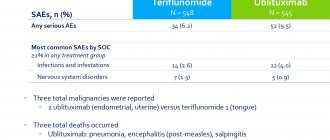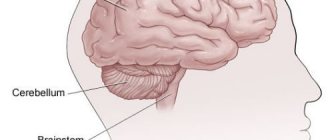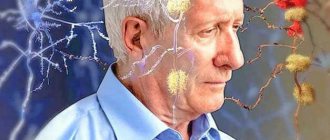Diagnostics
To determine multiple sclerosis, doctors use interviews and neurological examinations, and then confirm the diagnosis with MRI studies and tests.
MRI scans the brain and spinal cord for old and new lesions. For better visualization of fresh plaques, contrast is used. The diagnosis is made if the patient has 4 or more foci of demyelination measuring at least 3 mm, or 3 foci near the lateral ventricles, in the brain stem, cerebellum or spinal cord. In addition to MRI, the following may be prescribed for multiple sclerosis:
- regular blood tests to determine the level of immunoglobulins in the cerebrospinal fluid;
- lumbar punctures to study the composition of the spinal cord fluid.
How to stop multiple sclerosis: treatment of different forms of the disease
Unfortunately, despite progress in MS therapy, it is not yet possible to completely defeat the disease. However, if a person has multiple sclerosis, treatment can help reduce symptoms and reduce the number of relapses. Therapy is prescribed depending on the severity of the disease.
For progressive forms of MS, treatment can help reduce the severity of the disease. Specialists can prescribe:
- plasmapheresis - purification of the patient's blood;
- immunosuppressants - drugs that artificially suppress the immune system;
- immunomodulators are medications that regulate the body's immune response.
To prevent relapses, B-interferons can be used, and to reduce the intensity of symptoms, the following are used:
- vitamins E and B complexes;
- nootropics that improve brain activity;
- anticholinesterase drugs that inhibit the activity of the nervous system;
- muscle relaxants that help reduce muscle tone;
- enterosorbents that help remove toxins.
Symptoms of Multiple Sclerosis
In the case of multiple sclerosis, symptoms do not always correspond to the stage of the pathological process; exacerbations can recur at different intervals: even after several years, even after several weeks. And a relapse can last only a few hours, or can last up to several weeks, but each new exacerbation is more severe than the previous one, which is due to the accumulation of plaques and the formation of confluent plaques that cover more and more new areas. This means that Sclerosis Disseminata is characterized by a remitting course. Most likely, because of this inconstancy, neurologists have come up with another name for multiple sclerosis - chameleon.
The initial stage is also not very clear; the disease can develop gradually, but in rare cases it can give a rather acute onset. In addition, in the early stage, the first signs of the disease may not be noticed, since the course of this period is often asymptomatic, even if plaques already exist. This phenomenon is explained by the fact that with a few foci of demyelination, healthy nervous tissue takes over the functions of the affected areas and thus compensates for them.
In some cases, a single symptom may appear, such as blurred vision in one or both eyes in the cerebral form (ocular variety) of SD. Patients in such a situation may not go anywhere at all or limit themselves to a visit to an ophthalmologist, who is not always able to attribute these symptoms to the first signs of a serious neurological disease, which is multiple sclerosis, since the optic nerve discs (ON) may not have changed their color yet (in the future in MS, the temporal halves of the optic nerve will become pale). In addition, it is this form that gives long-term remissions, so patients can forget about the disease and consider themselves completely healthy.
The progression of multiple sclerosis causes the following symptoms:
- Sensitivity disorders occur in 80-90% of cases. Unusual sensations such as goosebumps, burning, numbness, itching of the skin, tingling, and transient pain do not pose a threat to life, but bother patients. Sensory disturbances begin from the distal parts (fingers) and gradually cover the entire limb. Most often, only the limbs of one side are affected, but symptoms can also transfer to the other side. Weakness in the limbs initially disguises itself as simple fatigue, then manifests itself as difficulty performing simple movements. The arms or legs become as if foreign, heavy, despite the remaining muscle strength (the arm and leg on the same side are most often affected).
- Visual impairment. On the part of the organ of vision, there is a disturbance in color perception, the development of optic neuritis and acute loss of vision are possible. Most often, the lesion is also unilateral. Blurry and double vision, lack of coordination of eye movements when trying to move them to the side - all these are symptoms of the disease.
- Tremor. It appears quite often and seriously complicates a person’s life. Trembling of the limbs or torso, which occurs as a result of muscle contractions, deprives normal social and work activities.
- Headache. Headache is a very common symptom of the disease. Scientists suggest that its occurrence is associated with muscle disorders and depression. It is with multiple sclerosis that headaches occur three times more often than with other neurological diseases. Sometimes it can act as a harbinger of an impending exacerbation of the disease or a sign of the onset of pathology.
- Swallowing and speech disorders. Symptoms accompanying each other. Swallowing disorders in half of the cases are not noticed by the sick person and are not presented as complaints. Changes in speech are manifested by confusion, scantiness, blurred words, and slurred presentation.
- Gait disorders. Difficulties while walking can be caused by numbness of the feet, imbalance, muscle spasms, muscle weakness, and tremors.
- Muscle spasms. They are quite common in the multiple sclerosis clinic and often lead to disability of the patient. The muscles of the arms and legs are subject to spasms, which deprives a person of the ability to adequately control the limbs.
- Increased sensitivity to heat. Symptoms of the disease may worsen when the body overheats. Similar situations often occur on the beach, in the sauna, in the bathhouse.
- Intellectual, cognitive impairment. Relevant for half of all patients. Mostly they are manifested by a general inhibition of thinking, a decrease in the ability to memorize and a decrease in concentration, slow assimilation of information, and difficulties with switching from one type of activity to another. This symptomatology deprives a person of the ability to perform tasks encountered in everyday life.
- Dizziness. This symptom occurs early in the development of the disease and worsens as it progresses. A person can feel both his own instability and suffer from the “movement” of the environment around him.
- Chronic fatigue. Very often accompanies multiple sclerosis and is more typical in the second half of the day. The patient feels increasing muscle weakness, drowsiness, lethargy and mental fatigue.
- Sexual desire disorders. Up to 90% of men and up to 70% of women suffer from sexual dysfunction. This disorder can be a consequence of both psychological problems and the result of damage to the central nervous system. Libido drops, the process of erection and ejaculation is disrupted. However, up to 50% of men do not lose their morning erections. Women are unable to achieve orgasm, sexual intercourse can be painful, and there is often a decrease in sensitivity in the genital area.
- Autonomic disorders. Most likely indicates a long course of the disease, and rarely manifests itself at the onset of the disease. Persistent morning hypothermia, increased sweating of the feet coupled with muscle weakness, arterial hypotension, dizziness, and cardiac arrhythmia are noted.
- Problems with night rest. It becomes more difficult for patients to fall asleep, which is most often caused by spasms of the limbs and other tactile sensations. Sleep becomes restless, as a result, during the day a person experiences dullness of consciousness and lack of clarity of thought.
- Depression and anxiety disorders. Diagnosed in half of patients. Depression can act as an independent symptom of multiple sclerosis or become a reaction to the disease, often after the diagnosis is announced. It is worth noting that such patients often make suicidal attempts; many, on the contrary, find a way out in alcoholism. Developing social maladaptation of the individual ultimately causes the patient’s disability and “overshadows” existing physical ailments.
- Intestinal dysfunction. This problem can manifest itself either as fecal incontinence or recurrent constipation.
- Disorders of the urination process. All symptoms associated with the process of urination in the initial stages of the disease worsen as it progresses.
Secondary symptoms of multiple sclerosis are complications of existing clinical manifestations of the disease. For example, urinary tract infections are a consequence of bladder dysfunction, pneumonia and bedsores develop due to limited physical capabilities, thrombophlebitis of the veins of the lower extremities develops due to their immobility.
Rehabilitation for multiple sclerosis
- Physiotherapy.
Exercise therapy helps improve a person’s condition with impaired motor activity. Working out on exercise machines helps restore coordination of movements. With correctly selected loads, the method demonstrated excellent efficiency. - Physiotherapy.
For patients with MS, electrophoresis, myostimulation, ultrasound, and magnetic therapy are recommended. These techniques help to activate the body's metabolic processes and reduce inflammation. - Massage.
For multiple sclerosis, this rehabilitation method can be used to relieve pain symptoms and spasms. Massage also helps improve muscle tone when it decreases.
Rehabilitation for multiple sclerosis also includes psychotherapy, which will help the patient cope with negative thoughts, as well as consultations with a nutritionist.
Disease prognosis
Multiple sclerosis is not considered a fatal disease; the unpleasant symptoms of MS can be quite successfully treated. Scientists have found that thanks to modern treatment, the life expectancy of patients today has increased significantly compared to those who fell ill even a few decades ago.
Overall, people with multiple sclerosis live on average 7 years less than the general population. Often, a decrease in life expectancy is associated with complications of other pathologies: cancer and cardiovascular diseases. For many patients, quality treatment can prevent a decline in quality of life and productivity. According to the National Multiple Sclerosis Society, ⅔ of people with MS are wheelchair-free even 20 years after diagnosis.
Disability in multiple sclerosis
| If multiple sclerosis has caused disability for 5 months or more within a year, the patient can apply for disability registration. |
After reviewing the documents, the commission will make a decision on incapacity for work, which gives the right to receive a pension and preferential working conditions. The establishment of a disability group is influenced by:
- the period for which the ability to work was lost;
- the period when the patient was registered with this disease;
- frequency, duration and severity of exacerbations;
- therapy results;
- changes in the course of the disease, the rate of development of symptoms.
Disability is assigned for a year, after which it is necessary to pass the commission again. Disability of groups I and II with MS gives the right to a reduced working day - 35 hours per week. In this case, wages are paid in full.
Causes of sclerosis development
The exact cause of multiple sclerosis is not clearly understood. Today, the most generally accepted opinion is that multiple sclerosis can arise as a result of a random combination of a number of unfavorable external and internal factors in a given person.
Unfavorable external factors include
- geo-ecological place of residence, its influence on the body of children is especially great;
- injuries;
- frequent viral and bacterial infections;
- influence of toxic substances and radiation;
- nutritional features;
- genetic predisposition, probably associated with a combination of several genes that cause disturbances primarily in the immunoregulatory system;
- frequent stressful situations.
In each person, several genes simultaneously participate in the regulation of the immune response. In this case, the number of interacting genes can be large.
Recent studies have confirmed the mandatory participation of the immune system - primary or secondary - in the development of multiple sclerosis. Disorders in the immune system are associated with the characteristics of the set of genes that control the immune response. The most widespread is the autoimmune theory of the occurrence of multiple sclerosis (recognition of nerve cells by the immune system as “foreign” and their destruction). Considering the leading role of immunological disorders, treatment of this disease is primarily based on the correction of immune disorders.
In multiple sclerosis, the NTU-1 virus (or a related unknown pathogen) is considered as the causative agent. It is believed that a virus or a group of viruses causes serious disturbances in immune regulation in the patient’s body with the development of an inflammatory process and the breakdown of the myelin structures of the nervous system.
What is secondary progressive multiple sclerosis and how to resist the disease
There are several types of multiple sclerosis. About 15% of patients develop primary progressive MS (PPMS). This form is characterized by transience, in which neurodegenerative processes predominate from the very beginning, which is why neurological symptoms quickly increase. The majority (up to 90%) of patients are diagnosed with relapsing-remitting MS (RRMS): with it, periods of exacerbation are followed by periods of remission with complete or incomplete restoration of functions. In every second case, RRMS will eventually develop into a more severe form - secondary progressive MS (SPMS). In Russia, SPMS is observed in approximately 80 thousand people.
Signs that RMS has begun to transform into SPMS are considered to be an increase in the patient's neurological symptoms continuously for six months. And it seems that the time has come for remission, but instead there is an increase in neurological deficit. One of the key indicators of the development of SPMS is the inability to return to baseline values after an exacerbation. However, at this stage, patients may not notice any worsening. If after an exacerbation a symptom, for example pain in the legs, goes away, then as it progresses the symptoms increase gradually, so the general deterioration can be assessed only after some time. For example, after three months the patient understands that if previously he could easily walk a kilometer, now he can hardly overcome 500 meters.
To assess the progression of the disability, doctors use various tests, such as measuring the time it takes a patient to walk 25 steps, testing fine motor skills, and cognitive abilities.
And yet, there are no clear criteria for diagnosing this type of MS, so a combination of symptoms is taken into account (at the same time, in Russia, SPMS is detected with a delay of 2–3 years, sometimes already at this stage patients first learn that they have multiple sclerosis). Degeneration processes begin to prevail over inflammatory processes. A person begins to rapidly weaken, lose working capacity, and it becomes more and more difficult for him to move; There may be problems with speech, swallowing, motor skills, imbalance, as well as spasms, fatigue, pain, depression, unsteadiness when walking, and frequent urge to urinate. In 58–80%, cognitive abilities (memory, speech, attention, perception, speed of thinking) are also affected. 92% of patients with SPMS today have a disability.
SPMS has an early form, when the inflammatory process is still active and causes periodic exacerbations of the disease. In addition, there is secondary progressive MS without exacerbations (or inactive), when the disease progresses in the absence of exacerbations.
Many Russian patients find themselves isolated from society due to illness, become depressed, and lose their jobs and families. According to the Patient Quality of Life Survey, more than 70% of people with SPMS have been forced to leave or have lost their job. Most need help with everyday life and technical means of rehabilitation.
However, if diagnosed early and treated promptly, patients have a chance to live a long and happy life. For example, today in Europe people with MS live on average as long as in the general population. Science does not stand still, and every year new drugs become available for patients with MS, new mechanisms of action and drug dosage regimens appear that allow courses of therapy.
Thus, in our country several drugs have been registered for the pathogenetic treatment of relapsing-remitting MS. They are called “course-modifying drugs for MS” - DMTs. They reduce the frequency and severity of exacerbations, slow the rate of progression, neurological deficits, and also delay the development of cognitive impairment. Their early administration can help prevent the patient from developing SPMS. In addition, some drugs in this group are also prescribed for active SPMS, since they affect inflammatory activity.
In addition, a targeted drug has recently appeared in Russia for the treatment of secondary progressive multiple sclerosis, regardless of how it proceeds - with or without exacerbations. Unlike drugs that suppress inflammatory activity and reduce the frequency of exacerbations, the new drug can slow down the progression of the disease and the onset of disability. Moreover, the drug has a positive effect on the cognitive sphere and reduces the frequency of exacerbations.
The sooner treatment is started to reduce the activity of the inflammatory process and slow down the growth of brain damage, the more effective the therapy will be and the greater the chance of delaying severe consequences for many years. Indeed, as the processes of neurodegeneration progress, the disease becomes more difficult to treat and the prognosis of patients worsens. However, the fact that drugs have already emerged to treat even the most severe type of SPMS is encouraging.









